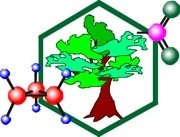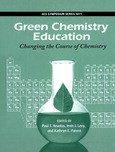|
|
Greening Chemistry
Greening chemistry? Imagine teaching chemistry with the benefit of the planet and everyone living on it in mind. The American Chemical Society, whose motto is Chemistry for Life, has as its mission "to advance the broader chemistry enterprise and its practitioners for the benefit of Earth and its people."
That is green chemistry.

The education of chemists and all those interested in chemistry is an ever-evolving endeavor to keep up with the latest innovations, discoveries, concepts, perspectives and techniques of the field. One of the most exciting developments in recent years is the development of green chemistry — the design of chemical products and processes that reduce or eliminate the generation of toxic substances.
— Paul T. Anastas and Evan S. Beach

The first time that chemistry meant anything more to me than concoctions in the kitchen sink or studying the periodic table in secondary school is etched in my memory. It's the image of a lab coat-clad man standing in a laboratory, railing against the findings of Rachel Carson in her controversial 1962 book Silent Spring. His vehemence was a clue to me that Carson's book had threatened his worldview. But his arguments also pointed to the ecological illiteracy that comes from reductionism — in this case, too much time spent experimenting in the chemistry lab and not enough time spent studying the impacts of the chemicals produced there.
 Silent Spring was a wake-up call for a world that had accepted chemical innovations (such as synthetic pesticides) without critical reflection on potential unintended consequences. Carson's book is often viewed as the start — the catalyzer — of the environmental movement, and is a must-read for any "green" chemistry teacher.
Silent Spring was a wake-up call for a world that had accepted chemical innovations (such as synthetic pesticides) without critical reflection on potential unintended consequences. Carson's book is often viewed as the start — the catalyzer — of the environmental movement, and is a must-read for any "green" chemistry teacher.

These sprays, dusts, and aerosols are now applied almost universally to farms, gardens, forests, and homes — nonselective chemicals that have the power to kill every insect, the "good" and the "bad," to still the song of birds and the leaping of fish in the streams, to coat the leaves with a deadly film, and to linger on in soil — all this though the intended target may be only a few weeds or insects. Can anyone believe it is possible to lay down such a barrage of poisons on the surface of the earth without making it unfit for all life? They should not be called "insecticides," but "biocides."
— Rachel Carson, 1962
Greening chemistry is relatively new. This branch of chemistry was conceived to help reduce or eliminate the sorts of hazardous substances Carson wrote about. Chemistry educator Dorothy Warren calls it "chemistry for the environment — a philosophy and way of thinking that can help chemists in research and production to develop more eco-friendly and efficient products and processes."
Hopefully, all chemistry will transition to green chemistry one day. Our students' vested interest in a sustainable future certainly calls for it, and it has an important place in the chemistry classroom and curriculum. Indeed, some people believe that greening chemistry, making it more relevant to everyday living, can attract students to the field of chemistry who might never have seen themselves as potential chemists let alone scientists.
Chemistry teachers can contribute to greening chemistry and transformative sustainability education by helping their students
- develop (or maintain!) their curiosity and sense of awe and wonder about how things work, promoting their fascination with potions and concoctions at an early age and their eagerness to invent things in their pre-teens, but always with health and safety in mind

- learn about and learn to respect the 12 principles of green chemistry, in age appropriate ways (for example, this can start in kindergarten when making something like gloop; because it will clog drains, it's important to discuss with students beforehand how to dispose of it safely when they're finished playing with it, though it can be kept wrapped in plastic for storage)
- think out loud about classroom disposal decisions you have to make as a class (for example, are your glues and paints nontoxic, and how should leftovers be dealt with — sink, garbage, compost, toxic waste disposal?)
- see that chemicals that are less hazardous to human health and the environment are also
- less toxic to organisms and ecosystems
- not persistent or bioaccumulative in organisms or the environment, and
- inherently safer with respect to handling and use
(with thanks to the US Environmental Protection Agency or EPA)
- learn the adverse effects of chemicals on human health and the environment, integrating lessons in basic toxicology, including dose-response and the hazard/exposure/risk paradigm, with their health and physical education
- understand and use Life Cycle Analysis (LCA) and the principles of sustainable development when discussing chemical issues and innovations
- see that in common with most sustainability issues, greening chemistry often involves making compromises and trade offs (for example, reducing the energy used in a particular process might mean using slightly more toxic substances, or vice versa (with thanks to a Working Party of the Environment, Health and Safety Committee [EHSC] of the Royal Society of Chemistry)

- look for situations where chemistry can assist food growing, in benign (nontoxic) ways that use Nature as inspiration — your school has a school garden, right? (thanks to William M. Nelson for this idea)
- when studying solutions and solubility, and relating these to everyday applications, examine your school's water quality (looking especially for lead and other contaminants)
- when studying gases and atmospheric chemistry, check the global warming potential (CO2 equivalent values) of various gases and find out if they are discharged around your school and if so, in what quantities

Why green chemistry? There is no doubt that our lives have been enhanced by chemistry. That is something chemists and students need to celebrate. However, environmental problems such as DDT, ozone depletion, the Love Canal, Bhopal, and the Cuyahoga River are all too familiar examples of chemistry gone wrong. In responding to the growing concern, governments introduced regulations to limit pollution and exposure to hazardous chemical and materials. Green chemistry represents a fundamental shift from this model toward a pollution prevention paradigm. Its premise is that a benign process and product presents no risk.
— Dennis L. Hjeresen, David L. Schutt, and Janet M. Boese, in Green Chemistry and Education
- describe the pros and cons of different chemical advances and their impacts on technology, society and the built and natural environments
- when studying hydrocarbons and energy, examine different characteristics of your school's carbon footprint, such as direct versus indirect greenhouse gas emissions (for example, relative to methane from your school's garbage going to landfill vs electricity required to pump your school's water and treat its wastewater)

- when learning about chemical structures and properties, study the chemistry of thin-film solar cell technology and other new inventions
- when studying energy changes and rates of reaction, compare conventional and alternative sources of energy with respect to efficiency and environmental impact
- when learning about chemical systems and equilibrium, be able to explain the importance of chemical equilibrium in ecological, biological and technological systems
- develop a holistic rather than a reductionist ("chemistry only") perspective (no offense, but I've worked in schools where the chemistry students felt they were superior to the biology and environmental systems students — forgetting that many of today's environmental problems were created by chemists who forgot that everything is interconnected)
- when studying electrochemistry, to work with your school's Solar Club to teach its members the interconversion of chemical and electrical energy (your students could also teach classmates and younger students about safe disposal of batteries through your school's battery recycling initiative)
- ponder how to minimize possible adverse environmental impact, increase lab safety, and decrease generation of waste and the costs of waste disposal in the school's labs through re-evaluation of your school's laboratory philosophies, practices, procedures and experiments (thanks to Thomas E. Goodwin at Hendrix College for this idea)

- see that public understanding of many sustainability issues lags behind awareness; in an organic chemistry unit, provide examples of organic chemistry involved in health, safety and environmental issues (for example, have students determine whether your school contributes to ozone depletion, or have students carry out lab investigations into pesticide residues and bioaccumulation to help your school's cafeteria make informed decisions on the benefits of serving organic foods)
- learn chemistry by integrating green chemistry with civic engagement, to give the chemistry curriculum some everyday context (according to Richard Gurney and Sue Stafford, "when introduced to green chemistry in context, students are driven to learn so that they are able to effectively educate and advocate for [it] in their community")
- share the vision and ideas of green chemistry with others, through an organic forum or other outreach and communication strategy (thanks to Irvin Levy and Ronald Kay for this idea)
The Principles of Green Chemistry
The textbook Green Chemistry: Theory and Practice, by Paul T. Anastas and John C. Warner, lists the following 12 principles of green chemistry (adapted).
- Pollution Prevention It is better to prevent waste than to treat or clean up waste after it has been created.
- Atom Economy Design should maximize the incorporation of all materials used in the process into the final product, minimizing unnecessary waste.
- Less Hazardous Chemical Syntheses Wherever practicable, processes and products should be designed with little or no toxicity to human health and the environment.
- Designing Safer Chemicals Chemical products should be designed to be safe yet functional.
- Safer Solvents and Auxiliaries The use of auxiliary substances
(eg, solvents, separation agents, etc.) should be made unnecessary wherever possible and innocuous when used.
- Design for Energy Efficiency Use the least energy possible in the process or product, to minimize environmental and economic impacts. If possible, synthetic methods should be conducted at ambient temperature and pressure.
- Use of Renewable Feedstocks A raw material or feedstock should be renewable rather than depleting whenever technically and economically practicable.
- Reduce Derivatives Unnecessary derivatization (use of blocking groups, protection/deprotection, temporary modification of physical/chemical processes) should be minimized or avoided if possible, because such steps require additional reagents and can generate waste.
- Catalysis Use renewable catalysts rather than toxic chemicals as catalysts.
- Design for Degradation Chemical products should be designed so that at the end of their function they biodegrade into innocuous degradation products and do not persist in the environment.
- Real-time Analysis for Pollution Prevention Analytical methodologies need to be further developed to allow for real-time, in-process monitoring and control prior to the formation of hazardous substances.
- Inherently Safer Chemistry for Accident Prevention Chemical substances and processes should be chosen to minimize the potential for chemical accidents, including releases, explosions, and fires.
Resources for Greening Chemistry Teaching
The following resources help with greening chemistry and integrating it with education for sustainable development (ESD).
- Beyond Benign is a nonprofit organization that provides open access to K-12 education materials as well as teacher, industry, and community training in sustainability and green chemistry.

- Green Chemistry Education: Changing the Course of Chemistry documents and discusses current pedagogical approaches to incorporating green chemistry throughout all facets and at all levels of chemistry education.
- Chemistry in the Community is an alternative grade 10-12 curriculum for students who are not planning to study chemistry at university, designed to enhance public understanding of chemistry.
- Integrating Global Environmental Chemistry into Secondary School Curricula, a chapter by Carole Stearns in the book The Science of Global Change, suggests environmentally relevant examples of global issues to use in greening chemistry teaching at the high school level.
- The United States Environmental Protection Agency (EPA) Green Chemistry website offers several links on the topic.

- The American Chemical Society (ACS) observes Earth Day through its Chemists Celebrate Earth Day program, which offers events, contests and educational resources for chemistry enthusiasts everywhere, to illustrate the positive role that chemistry plays in the world. (CCED's aim is to bring international focus to environmental causes such as clean air, water, and energy — its Earth Day themes.)
- National Chemistry Week (sponsored by the ACS in October) produces educational resources on a different theme each year.
- The Warner Babcock Institute for Green Chemistry is a portal for several resources especially related to business and industry applications.
- The University of York's Green Chemistry Centre of Excellence includes an Introduction to Green Chemistry and an Education section that offers outreach activities for school students.

Green Chemistry is a call to arms for the next generation of students to study the physical sciences. The philosophy of green chemistry puts a subject, which is generally considered abstract and difficult, into a familiar context relevant to the daily lives of students. The practice of green chemistry ensures a sustainable future with safer alternatives to chemical products and processes.... The message of green chemistry resonates with students and can inspire students to pursue the sciences.
— Amy S. Cannon and John C. Warner
Return from Greening Chemistry to Integration
Go from Greening Chemistry to GreenHeart Education Homepage
|
|
|








